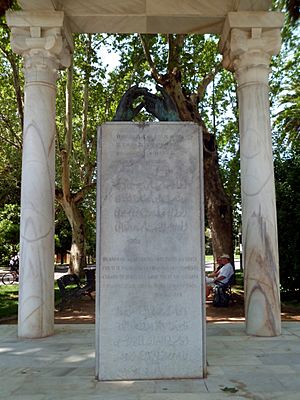Wallada bint al-Mustakfi facts for kids
Quick facts for kids Wallada bint al-Mustakfiولادة بنت المستكفي |
|
|---|---|
| Born | Wallada bint Muhammad 994 or 1001 Córdoba, Caliphate of Córdoba |
| Died | 26 March 1091 Córdoba, Taifa of Córdoba |
| Resting place | Córdoba, Spain |
| Dynasty | Umayyad |
| Occupation | Poet |
Wallada bint al-Mustakfi (Arabic: ولادة بنت المستكفي) was a famous poet from Al-Andalus (what is now Spain). She lived a long time ago, from around 994 or 1001 to 1091. Wallada was the daughter of Muhammad III of Córdoba, a ruler from the Umayyad family.
Contents
Wallada's Early Life
Wallada's father, Muhammad III, was one of the last rulers of the Caliphate of Córdoba. He became a leader in 1024. Two years later, he passed away. Wallada's mother was a Christian woman from the Iberian Peninsula.
Wallada grew up during a time when the Caliphate of Córdoba was very strong. Later, during her teenage years, the region faced many changes and conflicts. Different leaders tried to gain power, causing a period of unrest.
Since Muhammad III did not have any sons, Wallada inherited his wealth and properties. She used her inheritance to open a special place in Córdoba. This place was a palace and a literary hall. Here, she taught poetry and the arts to women from all backgrounds. This included women from noble families and even those who were formerly enslaved. Many important poets and thinkers of that time also visited her hall.
Wallada's Unique Style
Wallada was known for her beauty, intelligence, and education. She was also quite bold and did things that were unusual for her time. For example, she would walk in public without a veil. She also wore transparent tunics, which were common in the harems of Córdoba.
Some religious leaders thought her behavior was wrong. However, many people defended her, including Ibn Hazm. He was a famous writer known for his book The Ring of the Dove. Wallada became well-known for her poetry skills. This was especially impressive because poetry was mostly a male-dominated field back then.
One famous example of Wallada's poetry shows her brave personality. She had these verses embroidered in gold on the edge of her robe:
|
أَنَا وَاللهِ أَصْلُحُ لِلْمَعَالِي |
I am, by God, fit for high positions. |
Wallada and Ibn Zaydun
In Córdoba, poets often had friendly competitions. They would try to finish poems that were left incomplete. It was at one of these poetry events that Wallada met Ibn Zaydun. He was also a poet and a nobleman.
Their relationship was complicated because of Zaydun's family ties. His family was a rival to Wallada's Umayyad family. Because of this, their relationship had to be kept a secret.
Most of Wallada's surviving poems are about her relationship with Ibn Zaydun. Their relationship eventually ended. These poems show feelings of jealousy and longing. Some poems also express sadness and disappointment. Five of her poems are sharp criticisms of Zaydun.
After her relationship with Zaydun ended, Wallada became close with the vizier Ibn Abdus. He was a major political rival of Zaydun. Ibn Abdus was very fond of Wallada. He later had Zaydun's properties taken away and Zaydun was put in prison. Wallada then moved into the vizier's palace. She never married him, but he stayed by her side until he passed away when he was very old.
Wallada's Lasting Impact
One of Wallada's most talented students was Muhja bint al-Tayyani. Muhja was the daughter of a fig salesman. Wallada welcomed her into her home and taught her. After Wallada's death, Muhja wrote several kind poems about her teacher.
Images for kids
See also
In Spanish: Wallada bint al-Mustakfi para niños



